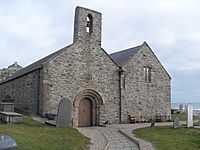St Hywyn's Church, Aberdaron facts for kids
Quick facts for kids Church of St Hywyn |
|
|---|---|

"The Cathedral of Llŷn"
|
|
| Lua error in Module:Location_map at line 420: attempt to index field 'wikibase' (a nil value). | |
| OS grid reference | SH173263 |
| Location | Aberdaron, Gwynedd |
| Country | Wales |
| Denomination | Church in Wales |
| History | |
| Status | Parish church |
| Founded | 5th–7th century |
| Architecture | |
| Functional status | Active |
| Heritage designation | Grade I |
| Designated | 19 October 1971 |
| Architectural type | Church |
| Administration | |
| Parish | Bro Enlli Ministry Area |
| Diocese | Bangor |
The Church of St Hywyn is an old church in Aberdaron, Gwynedd, Wales. It was built around the 12th century. But its story goes back even further, to a special kind of early Christian settlement called a clas church, from the 5th to 7th centuries. More parts were added later, like a second main hall (called a nave), in the late 1400s or early 1500s.
This church was very important because it was a starting point for people traveling to Bardsey Island. This island had an abbey (a monastery) and became a major place for pilgrimage (a special religious journey) during the Middle Ages. After the Reformation (a big change in the church in the 1500s), the church became less important and fell into ruin by the 1800s. A new church was built nearby, but people didn't like it much. So, St Hywyn's was fixed up and used again. The famous Welsh poet R. S. Thomas was a minister here. Today, it is a very important historic building, listed as Grade I.
Contents
History of St Hywyn's Church
Early Beginnings and Pilgrimage
The church's story began as a clas settlement between the 5th and 7th centuries. A clas was an early Christian community, often with a church and living quarters. This one was started by St Hywyn, an early Welsh Saint from Brittany.
The settlement became more important after 1190. That's when Bardsey Island, known as the "Island of 20,000 Saints," and St Davids in Pembrokeshire were declared special places for pilgrimage by the Papacy. Visiting both these Welsh sites was considered as important as one pilgrimage to Rome.
St Hywyn's Church grew a lot to welcome the many pilgrims sailing to Bardsey Abbey. These travelers would eat and drink at the Great Kitchen (Y Gegin Fawr) right next to the church. The current church building was first recorded in 1115. More construction happened in the 14th and 15th centuries.
Decline and Restoration
After the Reformation, the church faced hard times. For a long period, its clergy (ministers) did not live nearby. By the 1840s, the church was in ruins. A new church was then built further inland.
However, the new church was not popular with the local people. So, by 1868, the original St Hywyn's Church was restored and brought back into use. More repairs and updates took place in the 19th and 20th centuries. The church is sometimes called "The Cathedral of Llyn" because of its importance. It is still an active church today in the Bro Enlli Ministry Area.
The poet R. S. Thomas served as a minister at this church from 1967 to 1978.
Architecture and Design
Church Structure and Materials
The Church of St Hywyn has two main halls, called naves. They are the same length but were built at different times. The northern nave is mostly from the 12th century. The southern nave was built later, in the 14th century.
The building is made from rubble (rough, broken stones) and has slate roofs. It also features a bellcote, which is a small structure on the roof that holds a bell.
Interior Features
The inside of the church was updated in 2006. It has a special type of wooden roof called a hammerbeam roof. The arches inside, which form an arcade, are from the 15th century. They are described as "distinguished" in a famous book about the buildings of Gwynedd.
Inside the church, there are two carved stones. These stones remember two priests from the 5th or 6th century, named Veracius and Senacus. The church is a Grade I listed building, which means it's a very important historic site. Its listing says it is "one of the major churches of the Lleyn".
Notable Burials
The local herbalist Alice Griffith was buried here in 1821.

